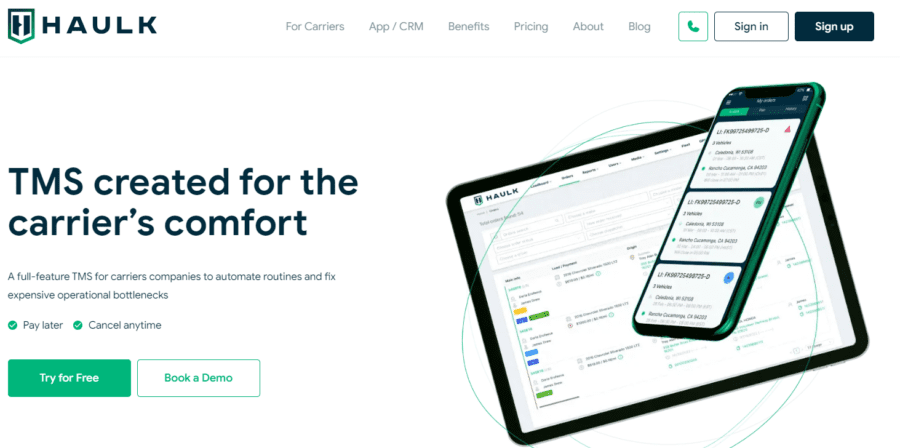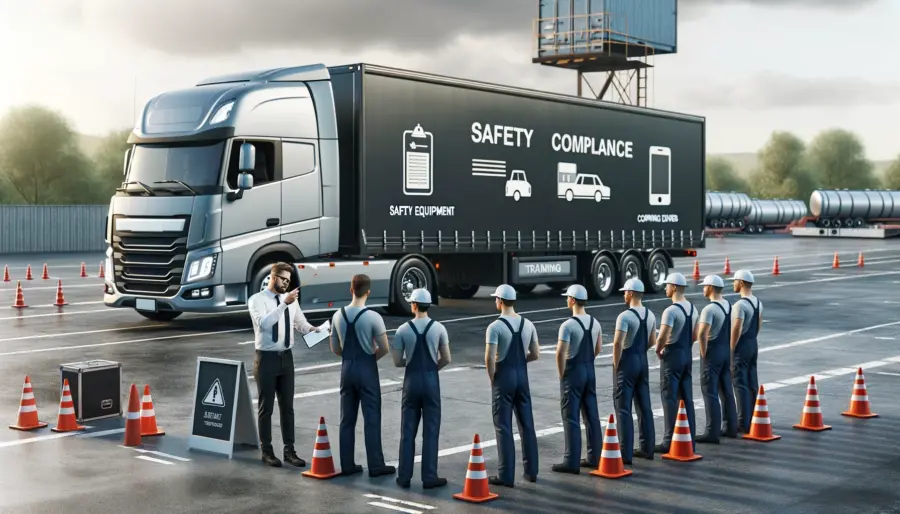
The vehicle transportation sector moves over $90 billion worth of cars and equipment annually in the United States alone. This essential industry keeps dealerships stocked, gets trade-ins moved between locations, and transports private vehicles where they need to go.
As demand for hauling services continues rising, now presents an opportune moment for entrepreneurs to launch car hauling businesses. But the path to success requires much more than just purchasing a truck and posting some flyers.
Careful planning and execution underpin profitable, sustainable car hauling operations. This guide will walk you through the essential steps, including:
- Analyzing the car hauling landscape
- Crafting a rock-solid business plan
- Complying with regulations and licensing
- Securing financing to get started
- Building your fleet and team appropriately
- Leveraging technology to enhance efficiency
- Delivering excellent service to customers
While launching a hauling company poses challenges, those who follow an organized methodology position themselves to unlock major rewards. Let’s explore the key phases in detail.
1. Understand the Car Hauling Market
Before setting up shop, it’s essential to immerse yourself in the car hauling segment to grasp key opportunities, clients, and competitors.
Analyze the Industry Landscape
Independent research is the only way to accurately assess the demand for hauling services in your region. You’ll need to identify:
- Major customers: What dealerships, auction houses, manufacturers, and other major clients operate in your area? What are their transport requirements?
- Private customer potential: How many individuals in your region buy, sell, or ship vehicles regularly enough to require hauling services?
- Infrastructure conditions: What highways, roads, ports, and distribution hubs connect your region? How do they impact routes and accessibility?
- Regulatory environment: What federal, state, provincial, and municipal regulations apply to haulers where you’ll operate? How do they impact costs?
Compiling this information will illustrate if sufficient transport demand exists, which niches appear most attractive, and how accessible desired routes are from an operating perspective.
While national data provides useful context, granular regional analysis is essential—California’s car culture makes it far friendlier for automobile transport than, say, North Dakota. Crunch the numbers for your specific target locations.
Assess Your Competitive Advantage
It’s critical to profile existing car hauling companies serving your target region. Assess:
- Competitors’ service offerings
- Pricing and business models
- Customer service reputation
- Fleet size and asset mix
Can you offer specific services competitors lack, such as enclosed trailers, rush deliveries, or vehicle preparation? Or provide better prices through lower overheads? Identifying strengths you possess, that rivals lack, will dictate your positioning.
For example, focusing exclusively on local vintage car transport creates a niche where mass-volume shippers are irrelevant. Specialization may enable commanding higher prices from an underserved customer segment.
You don’t need to beat competitors outright across the board—just carefully select differentiated value props.
2. Establish Operational Infrastructure
Streamlining coordination between drivers, dispatchers, administrators, and customers leverages technology to enhance professionalism, sustain rapid scaling, and reduce errors causing costly claims.
So, Investing in a transportation management system (TMS) purpose-built for auto haulers will save money while enhancing customer service.
Automate Manual Tasks
Most small carriers rely on makeshift spreadsheets and paper systems leaving room for error. A TMS software centralizes dispatch, equipment profiles, shipping documents, billing and more under one platform accessible across devices.
For instance, Haulk’s tms software for carriers enables creating dispatch orders directly from rate confirmations and shipping statuses update automatically via integrated GPS tracking. Customizable permission settings make delegation effortless.
Why Haulk?
Haulk’s carrier-centric design based on hands-on industry experience streamlines operations for auto hauling businesses of all sizes. Transportation CRM capabilities help nurture client relationships while order, vehicle and cost management modules enhance safety, compliance and profitability.
The intuitive interface works seamlessly on smartphones and tablets meeting drivers’ needs. Reliable in-app chat, email and phone support enable fixing problems quickly.
Here is a comparison table of manual methods vs Haulk’s software platform for car hauling businesses:
| Operation | Manual Methods | Haulk’s Software Platform |
|---|---|---|
| Dispatching | Manual call/email to drivers about new loads. Time consuming, error prone. | Automated order assignment to optimal driver based on algorithms. |
| Rate Confirmations | Entering details for each manually. Duplicate data entry. | Bulk import orders from email or API. |
| Documentation | Paper bills, insurance cards. Can be lost or damaged. | Digitizes forms for easy sharing from cloud. Protects from losses. |
| Tracking Shipments | Constant manual calls to drivers. Customer frustration. | Real-time location viewable to all. Auto ETAs. |
| Maintenance | No standard checklist. Issues slip through cracks. | Digital DVIR, reminders as per OEM specs. |
| Compliance | Pen-paper log audits. Time intensive. | ELD logs auto synced. Analytics flag violations. |
| Analytics | Basic manual tallying in spreadsheets. | Custom reports on safety, fleet usage, finance etc. |
| Customer Service | Limited insight into order issues. | Full visibility aids proactive updates. |
| Payments | Manual invoicing and following up. | Automates billing, integrates payment processing. |
The table illustrates how using Haulk’s modern transportation management system eliminates fruitless manual tasks for car haulers. The structured processes and real-time tracking not only boost efficiency but also improve compliance, safety and customer service.
Sign up for a free trial to experience benefits first-hand or schedule a custom demo matching Haulk to your workflows.
3. Develop a Business Plan
With detailed market research completed, it’s time to crystallize direction into a concrete car hauling business plan. This key document guides all subsequent startup steps.
Define Your Business Objectives
Start by outlining tangible short and long-term milestones reflecting what success looks like. For example:
Short term
- Launch operations within X months
- Offer local transport across 50-mile radius
- Build fleet to Y vehicles within first year
- Achieve 70% utilization rate
- Hit $Z in monthly revenue by month 12
Long term
- Expand service region over 5 years
- Grow fleet to over 50 vehicles
- Build partnerships with dealership chains
- Maintain 80%+ utilization rate
- Surpass $$ in annual revenue
Quantifiable objectives like this keep strategies aligned as you scale. They provide quick feedback on what’s working so you can adjust accordingly.
Plan Your Finances
With goals set, estimate costs across critical financial components:
Startup Costs
- Incorporation expenses
- License and permit fees
- Liability insurance
- Fleet purchases
- Vehicle branding
- Technology systems
- Talent acquisition
- Facilities
Ongoing Overheads
- Fuel
- Maintenance
- Insurance
- Technology subscriptions
- Payroll
- Facility leases
- Office expenses
- Professional services
- Finance costs
Analyze these expenditures relative to your milestones. For example, acquiring vehicles too early can leave expensive assets sitting idle—right-sizing your fleet and scaling gradually is key.
Build a capital requirement plan and projected financial statements. These will equip you to manage cash flow, identify funding needs, and monitor performance.
4. Fulfill Legal Requirements and Licensing
Car hauling operations interact with extensive regulations for safety assurance and compliance. The requisite permits vary by geography, so engage qualified legal and accounting support to navigate requirements.
Register Your Business
You must choose and formally register an appropriate business structure tailored to your circumstances between:
- Sole proprietorship
- General partnership
- Limited partnership
- Limited liability company (LLC)
- S corporation
- C corporation
LLCs offer owner protections with pass-through tax benefits, making them popular hauling startup structures. However financial situation, growth ambitions, and ability to comply with administrative formalities determine what entity works best.
After selecting your structure, officially register your business name and operating entity.
Obtain Necessary Permits and Licenses
Interstate transport falls under federal DOT authority mandating various operating credentials:
- USDOT number
- MC (motor carrier) number
- UCR (Unified Carrier Registration)
- IFTA (International Fuel Tax Agreement) Decals
Intrastate haulers may bypass USDOT but require state-issued authority to handle local transport. This can include business operating permits, special licenses, and equipment registration.
Drivers themselves need Commercial Driver’s Licenses (CDL) authorizing operation of commercial articulated trucks and tractor-trailers. Rigorous skills testing qualifies license holders to maneuver these challenging vehicles safely.
5.Secure Financing for Your Venture
With a business plan finalized, obtain necessary capital to activate operations through savings, investors, commercial loans, SBA programs, or alternate financiers tailored to transportation sectors.
Explore Funding Options
Tap personal assets—Leverage savings, home equity, retirement funds Attract investors—Pitch shareholders on your expertise and projections
Finance vehicles and equipment—Leverage asset collateral through lending products designed for haulers
Utilize credit—Credit cards, lines of credit, and overdrafts to manage short-term working capital
Leverage government programs—SBA loans bring long-term capital with advantageous terms for small business owners
Choose funding sources aligning with your risk tolerance and growth objectives. Combining multiple instruments often proves most effective long-term.
Above all, ensure adequate working capital remains available to fuel growth without crimping liquidity required to pay drivers, suppliers, insurance, and operating overheads.
6. Acquire the Right Equipment
Once financing secured, obtain well-maintained vehicles offer the hauling capacity, configurability, and resilience to serve customers reliably while optimizing efficiency.
Choose Your Fleet
- Trucks: Sturdy, maneuverable day cabs with 350+ HP engines, 6+ speed automated manuals, quad axle configurations rated for GCW up to 90K lbs.
- Trailers: hydronic tilt equipment trailers offer ultimate versatility for securely transporting vehicles. Gooseneck couplers on lowboy trailers allow greatest cargo capacity within regulated length limits.
- Specialized equipment: Winches, straps, and handling gear help load/offload efficiently. Onboard telematics capture real-time diagnostics. Backup cameras improve visibility.
Compare new vs used asset acquisition costs factoring useful lifespan, maintenance, reliability and loan terms. Gradually scale fleet size aligning with demand growth.
Maintain Your Fleet
Implement rigorous preventative maintenance routines extending truck lifespans and optimizing uptime:
- Follow OEM service interval guidelines
- Perform thorough 90-day inspections
- Address issues proactively, not just reactively
- Invest in driver safety training—proper operation drastically reduces repairs.
Building partnerships with reputable commercial dealerships ensures qualified mechanics service vehicles properly.
Build Your Team
Beyond robust technical infrastructure, skilled staff talent provides the human touch ensuring seamless operations:
- Drivers: Recruit safety-focused CDL holders with commercial driving experience and extensive license categories. Spotless records minimize insurance burden.
- Office staff: Centralize scheduling, customer service and back office admin to let drivers focus solely on operating vehicles.
- Management: Proven leaders overseeing fleet ops, finance, HR, and sales steer the business prudently as it scales.
Training programs and attractive compensation structures retain top talent long-term despite industry churn.
7. Develop Marketing and Customer Relationships
Once your business foundation firms up, securing a steady stream of hauling contracts sustains healthy utilization and revenue.
Implement Effective Marketing Strategies
- Digital presence: Ensure your website, online profiles and Search Engine Optimization make you discoverable geographically to prospects seeking shipping services.
- Industry directories: Actively list within relevant B2B platforms like transport load boards and automotive equipment auction portals.
- Local advertising: Radio spots on regional stations and strategically placed print/billboard ads keep your brand visible.
- Press releases: Getting featured within local business journals raises credibility.
- Cross-promotions: Coordinating with complementary providers like vehicle customization shops offers joint value.
Track lead generation quantitatively to double down on tactics demonstrating traction.
Deliver Exceptional Customer Service
Where commoditized transport options abound, stand out via white glove service:
- Proactively contact clients with status updates, not just progress reports upon request
- Carefully inspect cars pre and post shipment to validate condition
- Invite customer feedback to identify improvements
- Address issues promptly and fairly to protect your reputation
- Follow up post-delivery to solidify relationships
Exceptional support retains accounts and drives referrals.
8. Ensure Compliance and Safety
Despite the excitement of accelerating growth, staying diligent with risk management sustains quality long-term.
Maintain Regulatory Compliance
- Rigorously adhere to FMCSA Safety Measurement System limits on driver violations
- Perform mandatory vehicle inspections and maintenance
- Preserve accurate operational records to simplify audits
- Closely monitor new regulations to avoid infractions
Formalize compliance internally via policies, training, and oversight protective of your business interests.
Prioritize Safety Protocols
- Emphasize defensive driver skills, accident avoidance, and fatigue management through your training regimen
- Enforce maximum on-duty durations prior to mandatory breaks
- Install telematics to monitor driving behaviors
- Perform root cause analyses on any incidents to prevent recurrence
- Reward employees identifying risks and preempting problems
Safety and compliance greatly impact insurance premiums, risk mitigation, and continued operating authority. As the adage goes, “An ounce of prevention is worth a pound of cure.”
Conclusion
Launching a profitable, sustainable car hauling operation is no simple feat, but hugely rewarding for those with business acumen, strategic vision and effective execution who do it right.
This guide outlined actionable advice and lessons from veterans in the automotive transport segment to help first-time entrepreneurs. While the road ahead undoubtedly brings fresh lessons, we hope our insights give you a strategic head start.
When challenges arise, remember why you started this journey, and why car hauling stirs your passion. Clients need your services, employees rely on your leadership, and with focused perseverance, you will transform ambitions into reality one milestone after the next.
For a detailed proprietary checklist and tools to launch your car hauler, contact Haulk to speak with an industry specialist who can offer personalized guidance tailored to your questions and goals for getting started.
















